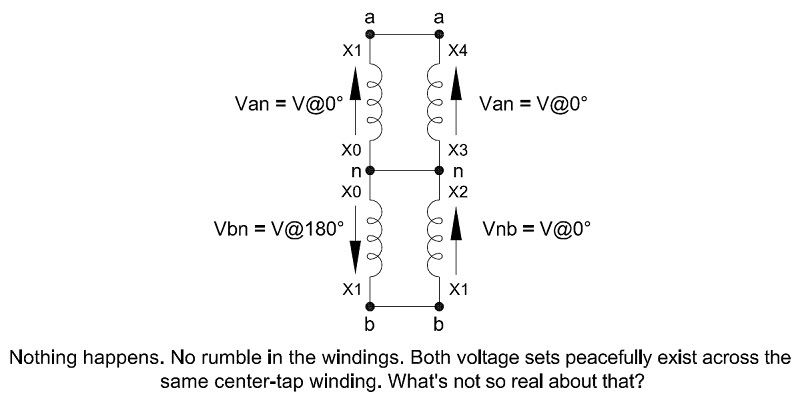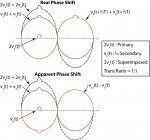- Location
- Wisconsin
- Occupation
- PE (Retired) - Power Systems
Why retract it when I can prove it?

Finally, graphical proof that Vbn is in-phase with Vnb.
Why retract it when I can prove it?

Again, it would help if you could keep up with the string of posts you are involved in. You stated the power flows back and forth in different directions:You would be the member that's posted about coal cars. And when I've mentioned trains it's been about current and the induced field. So from the above you've stated that we should not consider you a competent engineer.
Yea, I think I've mentioned electrons wiggling back and forth like they were part of a train. But the coal cars, and the "picking up" and "transporting" are all you Mivey.
During the first half cycle the power flows from A to B and therefore the voltage gradient is from A to B in proportion to the power flow. During the second half cycle the flow is from B to A
The energy flows along both wires towards the load. It travels in the electromagetic field surrounding the wires, not riding in the wires like a line of coal cars traveling back and forth.
Are you gonna tell me you think the current travels OUTSIDE the copper as Mivey stated?
...
The copper acts as a wave guide channeling the current through the electromagnetic field surrounding the wires. (per Mivey)
LoL, but a resounding NO. AC travels inside the copper to a depth determined by frequency.
Hardly. But if you want to ignore what the subscripts mean, I guess you can read it however you want.Finally, graphical proof that Vbn is in-phase with Vnb.
Prove it? You didn't even read the question, did you? How does that example prove whether the phase shift is real or apparent? Go back and reread the posting. I'm not arguing whether the two waveforms are in-phase or not. I'm arguing about your comments that your phase shift is not just an apparent phase shift but a real phase shift.Why retract it when I can prove it?
Prove it? You didn't even read the question, did you? How does that example prove whether the phase shift is real or apparent? Go back and reread the posting. I'm not arguing whether the two waveforms are in-phase or not. I'm arguing about your comments that your phase shift is not just an apparent phase shift but a real phase shift.
Besoeker already stated that 'uneventful' paralleling of two windings can only be possible when the two windings are in-phase. Your graphic shows Vbn and Vnb in parallel.Hardly. But if you want to ignore what the subscripts mean, I guess you can read it however you want.
You and I both know that a winding does not have a phase on its own. In this case, when we talk about the phase we are talking about the phase of a voltage waveform.Besoeker already stated that 'uneventful' paralleling of two windings can only be possible when the two windings are in-phase.
You and I both know that the positive peak of the Vbn waveform from the left is in phase with the negative peak of the Vnb waveform from the right.Your graphic shows Vbn and Vnb in parallel.
120302-1106 EST
Jim:
One of the voltages is labeled with @180. VNB = V@0 then equals VBN when VBN is defined as V@180.
.
AHHH - So it's labeling that permits the Tribe to screw with the sign, but V sin (wt + 180?) = - V sin(wt) {or V *-sin(wt)} is invalid?120302-1106 EST
Jim:
One of the voltages is labeled with @180. VNB = V@0 then equals VBN when VBN is defined as V@180.
.
Finally, graphical proof that Vbn is in-phase with Vnb.
AHHH - So it's labeling that permits the Tribe to screw with the sign, but V sin (wt + 180?) = - V sin(wt) is invalid?
The phase for both sides at t = 0 is 1, and for any other time t, the phaseare identical since that?s how identities work.
The issue is that you emphatically stated that it was not an apparent phase shift, but a real phase shift: That it was not mathematical, but what is really there. As a refresher for what you said, here are your quotes again:What do you consider the significance of whether one is phase shifted or not?
It isn't mathematically represented.
It's what happens in real life.
It's real.
So it is a physical fact, not just a mathematical equivalent, that we have 0? voltages and 180? voltages across the windings. The difference is which reference frame you use, but both are physical realities.
In other words, we have both in-phase voltages and phase-opposed voltages at the transformer.
No, we are not saying N must be used. We are saying that it is convenient and logical to do so, then V1n and V2n are as Bes says antiphase. They don't just appear to be so, they are. After all, V1n and V2n are what is seen on the bus bars in a residential panel.

Sorry, I cheated again; I edited after the fact, but the phase for every voltage function is identical.No, not at all. The identity is true, but the minus sign merely shifts the function by PI. We have known that since day one.
Just plot -sin(wt). The angular position is still (wt + PI). Same plot as sin(wt + PI). No change at all.
This discussion could be ended easily if someone would just provide a valid reference.
Look at your college Trig book on, identities and substitutions.No, not at all. The identity is true, but the minus sign merely shifts the function by PI. We have known that since day one. No actually you didn't, because t0 must be the same for all functions and there is no "phase shift" with regard to the start of the period.
Just plot -sin(wt). The angular position is still (wt + PI). Same plot as sin(wt + PI). No change at all. YES - the phase is identical throughout the "real" period 0 - 360o for both wt and wt + 180o
This discussion could be ended easily if someone would just provide a valid reference.
Look at your college Trig book on, identities and substitutions.
The issue is that you emphatically stated that it was not an apparent phase shift, but a real phase shift: That it was not mathematical, but what is really there. As a refresher for what you said, here are your quotes again:
If the phase shift is real, then the output will not be inverted, but shifted by 1/2T (half period). If the phase shift is apparent, then the output will be inverted, and not shifted.
To make the expressions easier to write, I assumed a unity, ideal transformer. The voltage functions are nondescript v(t)'s of period T. vx(t) is a small signal positive function of period T and superimposed on the primary voltage function.
Therefore, if the phase shift is real, as you claim, then vx(t) will appear in the positive half-cycle of the output and shifted by 1/2T. If the phase shift is apparent, as we all know, then vx(t) will appear in the negative half-cycle and not shifted.
View attachment 6545
The why have you habitually called it "Real" for the past several years that this discussion has taken place on this forum across multiple threads? Why have you refused to retract the statement when it was brought to your attention?Reference? Even if we do call it apparent, it matters not.
This was the defintion you supplied:Look at your college Trig book on, identities and substitutions.
Phase: Phase is the fractional part of a period through which time or the associated time angle wt has advanced from an arbitrary reference
[Kerchner and Corcoran, Alternating-Current Circuits, Wiley, 1951]

